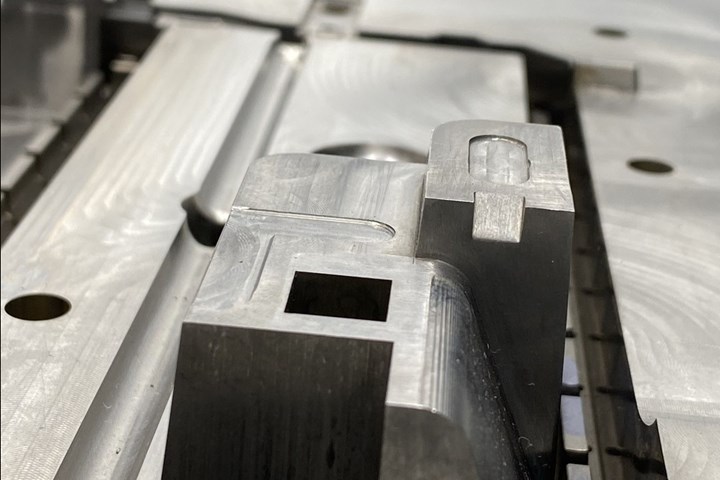How to Improve 3D-Printed Conformal-Cooled Mold Insert Performance
Coated conformal cooling channels can prevent scaling and corrosion in injection molds, increasing heat transfer, improving performance, and reducing outages.

Cleaning 3D-printed conformal cooling channels in tooling like this is a challenge, but the right surface treatment can help. Image courtesy of Alcadyne.
3D-printed molds with conformal cooling channels yield more efficient heat transfer, but the geometrically intricate channels may increase the likelihood of scaling. Scaling decreases flow and worsens the integrity of the cooling channel walls, which leads to leaking.
Maintenance solutions for eliminating scaling and corrosion range from cooling channels flushing with aggressive cleaning media that can damage the mold, to gentler ultrasonic cleaning that may be ineffective. Shops also opt to fix leaking cooling channels, which has high costs and downtime, and, in many cases, is not possible.
Another option for combating scaling and corrosion is to coat the inner diameter of the cooling channels. Most mold builders and parts manufacturers are familiar with electroplating or PVD coating mold surfaces to increase hardness and to extend mold life, but many do not realize that a surface treatment to the inner cooling channels will improve the lifespan of a mold’s interior as well.
Applying a thin layer of internal, ultra-thin, thermally conductive ceramic coating can provide several benefits that ultimately prolong the lifespan of the cooling channels, provide better uptime and save an injection molder money. The coating is thin enough (50-100 microns) that it has no measurable effect on heat transfer.
Another option for combating scaling and corrosion is to coat the inner diameter of the cooling channels.
This coating in the cooling channels has the following characteristics and benefits:
- The coating creates smooth walls that decrease scaling, as dissolved minerals and impurities have difficulty gaining a foothold in the channels.
- The coating provides a layer between the cooling water and the metal wall, preventing dissolved metals from occurring.
- A uniform coating throughout the inner diameter of the cooling channels promotes a uniform thermal gradient.
- The very hard coating (9.0 on Mohs Hardness Scale) limits pitting corrosion.
- The coating seals any micro cracks or voids that may have formed during fabrication or heat treating.
- The coating formulation is chemical-and solvent-resistant, allowing it to be used in conjunction with an aggressive chemical clean of the cooling channels during maintenance.
- After over 1,000 hours (ASTM B117) in a salt fog test the coating formulation exhibited no blistering, cracking, softening or delaminating, demonstrating robust resistance to water and mineral content.
The coating is also effective in fixing molds that leak as a result of inferior 3D prints with voids in the cooling channel walls or inadequate traditional mold fabrication. This coating application can serve as an inexpensive alternative to welding repair or mold replacement.
Before you start a production run with a new mold or retire a leaking mold, consider having the inner diameter of the cooling channels surface treated. This step will reduce maintenance stoppages, improve cycle times and reduce mold replacements.
Related Content
-
Questions and Considerations Before Sending Your Mold Out for Service
Communication is essential for proper polishing, hot runner manifold cleaning, mold repair, laser engraving and laser welding services.
-
Four Micro Tooling Considerations
Issues involving gating, ejection, mold splits and direction of pull are of special concern when it comes to micro tooling.
-
What is Scientific Maintenance? Part 2
Part two of this three-part series explains specific data that toolrooms must collect, analyze and use to truly advance to a scientific maintenance culture where you can measure real data and drive decisions.















